Boost pedals are a staple on the pedalboards of guitarists looking to elevate the impact of their playing without altering their fundamental tone. They serve a simple yet critical role in the signal chain: increasing the volume of a guitar signal, driving the front end of an amplifier harder, or pushing other effects pedals to their limits to create a wide range of dynamic and tonal possibilities. These versatile stompboxes can be used for a clean volume increase during solos, to add some grit, or even to achieve a more pronounced response from other effects units. Here’s some of the best boost pedal options we’ve come across that offer the best value in terms of price & performance.
When considering the best boost pedal for one’s needs, several factors come to the fore. The quality of the boost—whether it colors the tone or provides a transparent lift—is paramount. Build quality is also essential since reliability on stage or in the studio forms the backbone of a musician’s toolkit. Furthermore, the pedal’s headroom, which determines the amount of volume boost available before distortion, is crucial for maintaining clarity and precision.
In our quest to assist players in selecting the ideal boost pedal, we have explored various models, taking into account their circuitry types—ranging from clean to dirty boosts—and their footprint sizes to ensure they fit comfortably on pedalboards of all sizes. By prioritizing user-friendliness and evaluating the nuanced differences between features such as tone-shaping controls and bypass types, we remain committed to providing guidance grounded in comprehensive hands-on testing. We’re confident that our insights will lead you to a boost pedal that will not only enhance your playing dynamics but also integrate seamlessly with your existing setup.
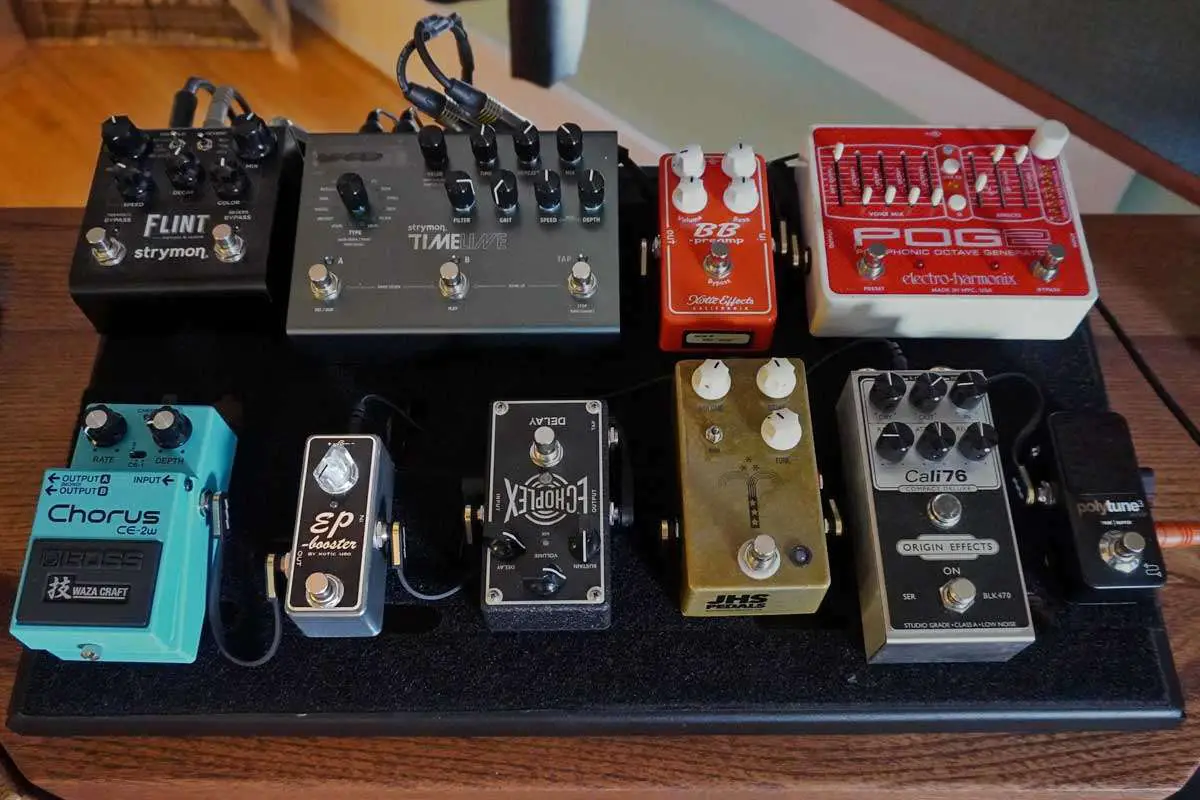
Top Boost Pedals for Elevating Your Sound
In our quest for the perfect tone, we have meticulously tested and gathered a selection of boost pedals that stand out in the realm of guitar gear. Each pedal on our list has been chosen for its ability to provide that extra edge to your sound, whether you’re looking for a subtle enhancement or a significant volume increase for solos. Our roundup reflects the best offered in durability, sound quality, and versatility, ensuring you’ll find the ideal pedal to invigorate your rig.
Xotic EP Booster
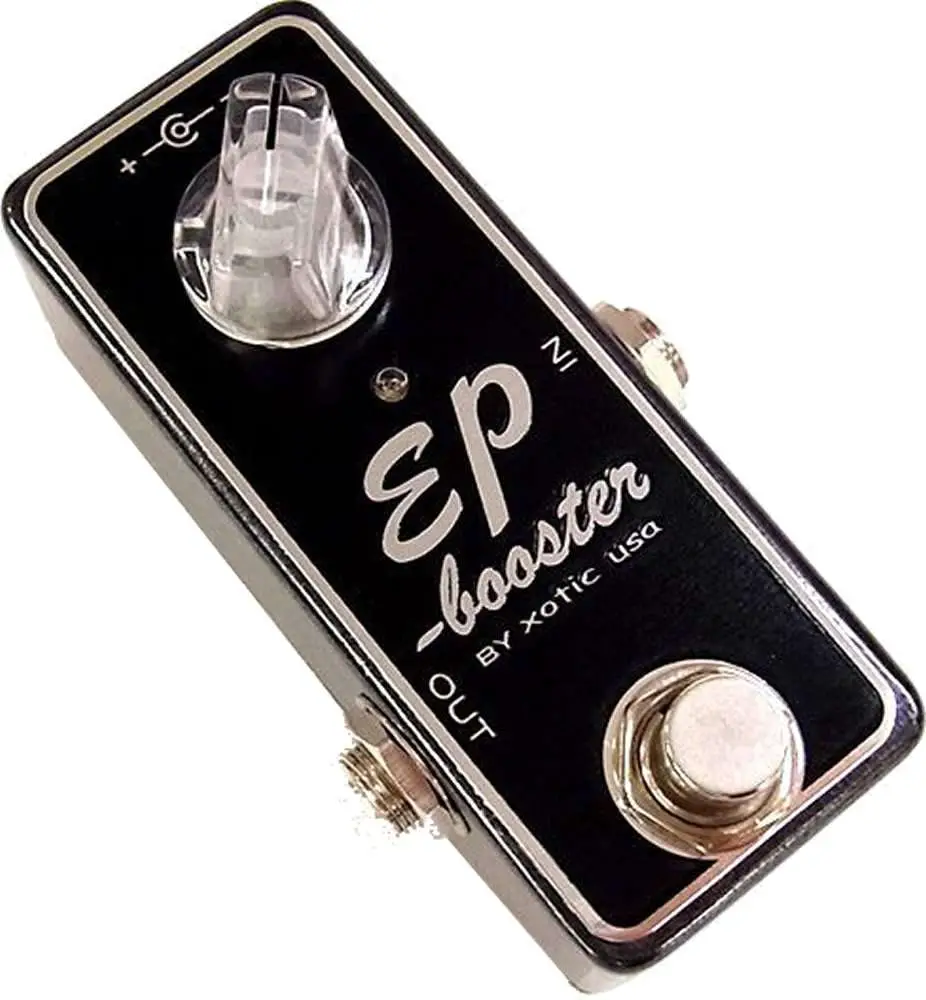
If you’re in the market for a clean boost that provides both sparkle and substance, the Xotic EP Booster deserves your attention.
Pros
- Enhances overall signal without compromising original tone
- Bass and Bright switches provide tonal flexibility
- Compact size fits any pedalboard
Cons
- May add too much coloration for those seeking transparent boost
- Single knob might limit some players who prefer more control options
- Can get noisy when gain is pushed to its limits
As soon as we stomped on the Xotic EP Booster, we could feel the life it breathed into our setup. The fact that it’s inspired by the Echoplex’s preamp means it doesn’t just amplify the sound – it enriches it. When playing a dark-sounding guitar through a clean amp, the shimmering boost the pedal provided made any chord or lead stand out without becoming harsh.
Fiddling with the internal DIP switches opened up a new level of customization. Engaging the Bass Boost switch gave a more rounded low end that served well for single coil pickups, ensuring they were never lost in the mix. It was quite satisfying to toggle the Bright switch off to bypass extra coloration for a more natural signal boost during a bluesy gig.
Despite its modest size, the pedal impressed us with its resilience and the amount of gain available. Even at low settings, the impact on our tone was obvious – more presence and a touch of warmth that felt like upgrading our entire rig. It was as if it pushed our amplifier just the right amount to make it sing. However, when pushed to extreme settings, things got a bit noisy, which is something to watch out for in a quieter setting.
The Xotic EP Booster isn’t just another boost pedal; it’s a tone enhancer that fits into an incredibly small package. After using it both in a band context and solo noodling, it’s clear why this little black box is a favorite among guitarists. Its ability to adapt yet enhance our sound made it a valuable addition to our pedalboard, but for those in search of a purely transparent boost, this might not be the first choice.
Jim Dunlop Boost Pedal
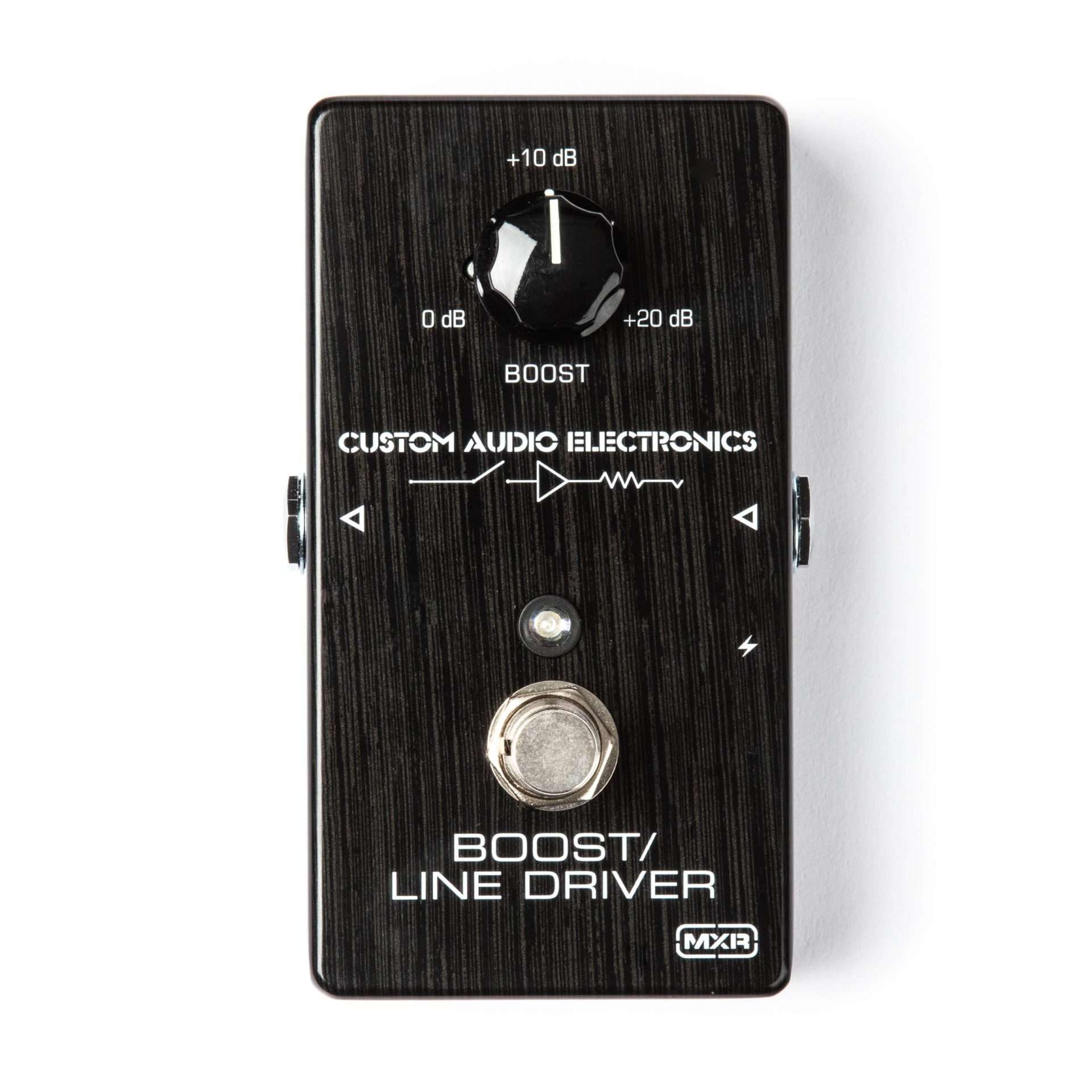
We found the Jim Dunlop Boost/Line Driver to be an indispensable tool for punching through the mix with a clean and powerful signal boost.
Pros
- Provides a transparent signal boost that preserves your original tone
- Dynamic responsiveness caters to your playing style
- High-quality build ensures reliable performance with other pedals
Cons
- May offer minimal boost when used with high-gain signals
- Requires a 9V battery or power supply, which is an additional expense
- Limited tonal shaping capabilities as it’s a straightforward boost pedal
When we put the pedal through its paces, the increase in volume was evident without altering our guitar’s fundamental sound. The responsiveness to picking dynamics really allowed us to express ourselves more fully, whether we were softening our touch or digging in for those passionate solo moments.
On stages and in studio sessions, it’s proven to be a breeze integrating it with our existing pedal setups. It’s minded its own business, doing its job without causing any unwanted noise or interference.
Even with active use, its solid construction suggests that it will be a companion for many gigs and recording sessions to come. However, it is essential to bear in mind that this is a pedal with a singular focus: it boosts your signal, which is perfect for solos or driving an amp harder, but it won’t color your tone with additional effects.
Keeley Mini Katana
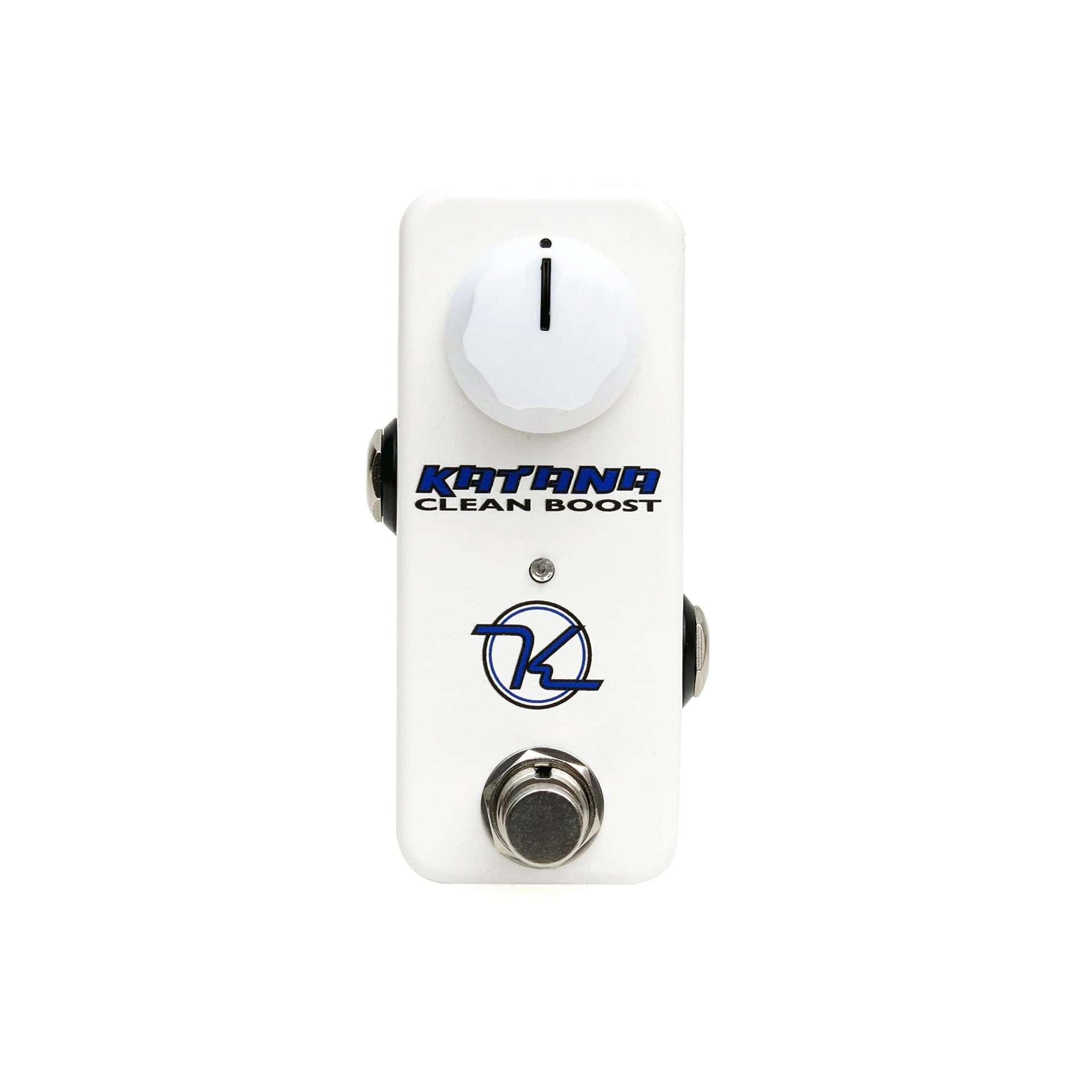
We think the Keeley Mini Katana is an excellent choice for guitarists looking to add a pure volume boost without altering their core tone.
Pros
- Maintains the integrity of the original tone
- Compact size conserves pedalboard space
- Provides a significant volume boost when needed
Cons
- Gain control is internal, which might be inconvenient for some
- The pedal is always on unless a battery is disconnected
- The minimal design may lack versatility for players seeking multiple boost modes
Keeley has always been a respected name in the pedal community, and the Mini Katana holds true to their reputation. Upon plugging in, we instantly noticed the clean lift in signal it provided—like your tone, only louder and clearer. Its simplicity is its strength; with one primary function, this pedal focuses on doing its job well.
Despite its small stature, the Mini Katana makes a sizable impact on your sound. It’s ideal for those tight spots on your pedalboard, and the build quality is solid, suggesting that it was made to withstand regular use. The true bypass design means there’s no signal interference when the pedal is off, keeping your signal path pure.
The versatility of the Mini Katana is somewhat limited by its design—offering a single boost function without external gain or tone control. However, we found that sometimes simplicity is invaluable, particularly when it’s providing an uncompromised volume increase. It’s become an “always on” pedal for us, enhancing our clean signal and giving us that extra oomph when it’s time to stand out in the mix.
Spark Mini Booster
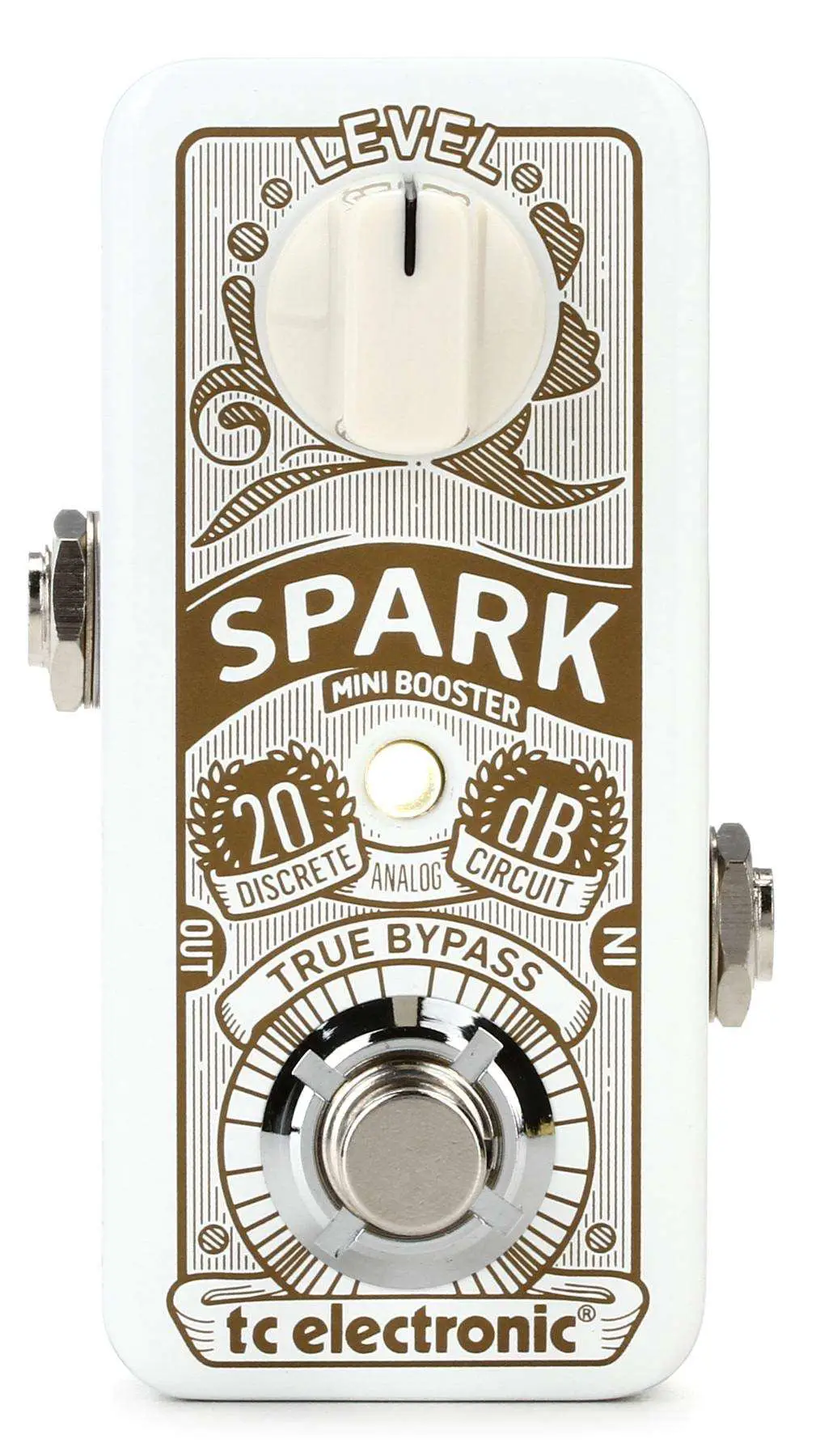
We found this tiny titan to be a must-have for those looking to enhance their sound without compromising tone.
Pros
- Offers a substantial 20 dB clean boost
- PrimeTime switching is innovative and practical
- Pure analog circuit maintains signal integrity
Cons
- Some may find the compact size too small
- Requires careful gain staging to avoid unwanted distortion
- Can introduce noise if not properly configured in a signal chain
After giving the Spark Mini Booster a thorough test run, we can confidently say this pedal is a powerhouse in a small package. The boost is crystal clear, amping up our signal without altering its natural character, which is essential for us purists.
The PrimeTime feature is a standout; the ability to switch between latching and momentary modes allows for on-the-fly versatility that’s perfect for dynamic live performances. We simply held down the footswitch longer for a temporary boost during solos.
We noticed you must be mindful of your gain settings. If you’re not careful, it could drive your amp harder than intended, which isn’t always a bad thing, unless you’re solely after a volume increase. But with a little finesse, you’ll find that sweet spot where everything sings.
In a live setup, the pedal’s small footprint was a space-saver — crucial on a crowded pedalboard. However, for those of us with larger feet or who prefer bigger targets to stomp on, its size might be less desirable.
We did experience some noise when the gain was cranked, typical of many boost pedals, especially in complex signal chains. It’s manageable, but worth noting for those with already noise-prone rigs.
Overall, the Spark Mini Booster offered us a simple yet effective solution to cut through the mix without losing our sonic identity.
JOYO Roll Boost
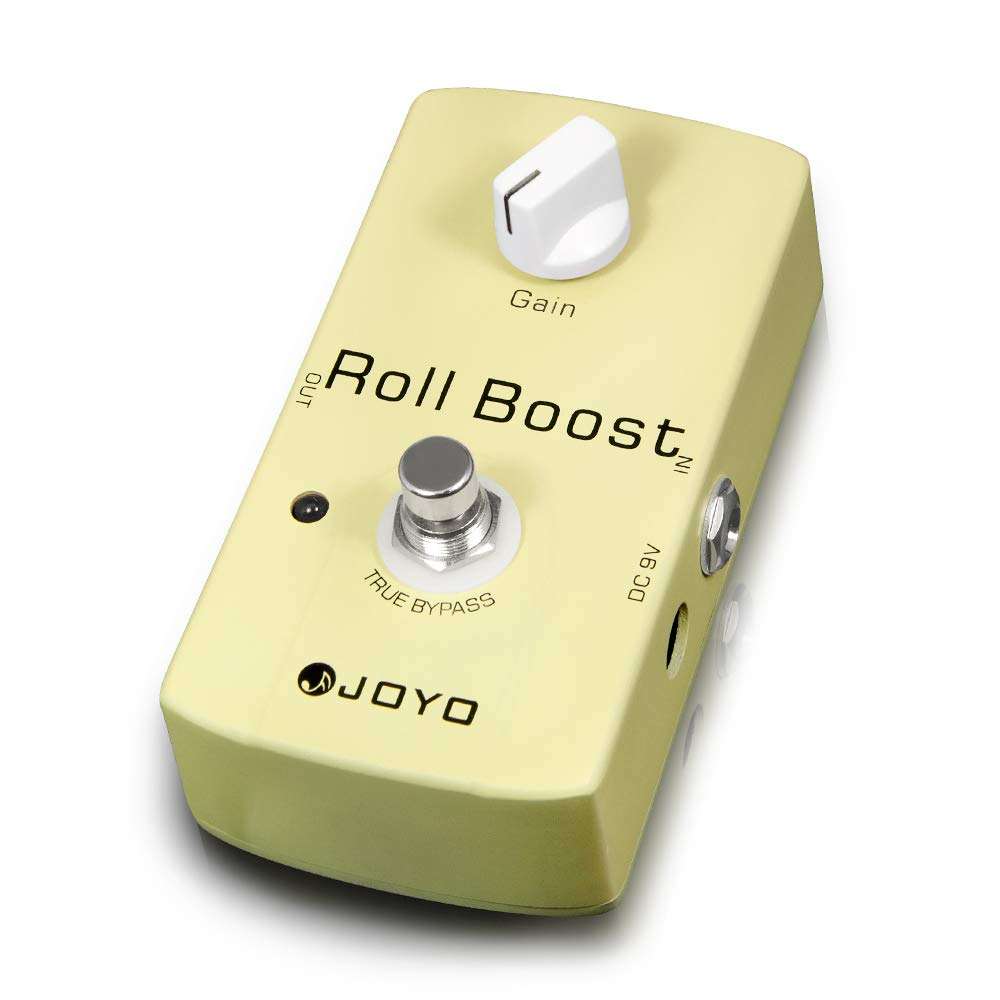
We found this pedal to be an invaluable addition to our rig, providing a significant clean boost without altering our core tone.
Pros
- Substantial 35dB boost amplifies signal without distortion
- True bypass circuitry preserves the original guitar tone
- Sturdy aluminum-alloy housing ensures durability
Cons
- Might require an additional power adapter for optimal performance
- Transparent boost may not add character if that’s what you’re seeking
- Battery replacement could be more convenient
Upon testing the JOYO Roll Boost, we immediately noticed the seamless integration into our pedalboard. The clear boost it offers is impressive, hitting the amp harder without changing the intrinsic sound of our guitar. This is especially useful when looking for volume increase in a solo without coloring the sound.
The build quality, in our experience, feels robust. The pedal’s aluminum-alloy housing seems like it can take a beating in our gig bag without any fuss. Moreover, the true bypass design is excellent for keeping our signal chain pure and unaffected when the pedal is disengaged.
However, we have to acknowledge that this pedal is quite the purist’s tool. Players looking for a boost pedal that adds its own flavor might not find what they’re looking for here. Also, we suggest investing in a dedicated power supply; it guarantees the pedal’s performance without any unwanted noise. While on the subject of power, changing the battery is more cumbersome than we’d like, involving screw removal.
All things considered, the JOYO Roll Boost made a positive impression on us. Its performance in offering a clear and powerful signal boost without tampering with tone quality is commendable. For musicians who value fidelity and want to elevate their existing guitar sound, this pedal is a strong contender.
VSN Mini Boost
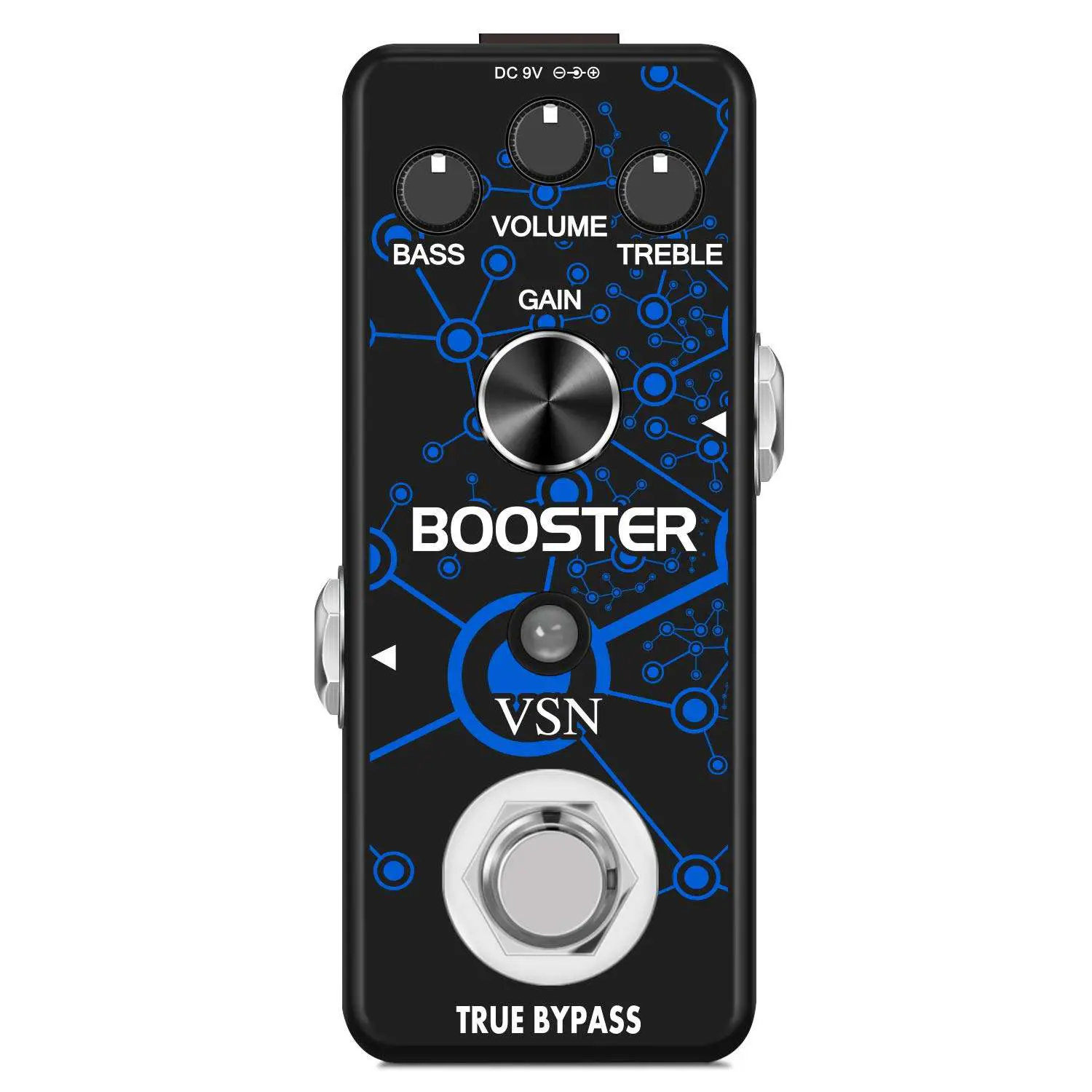
We think the VSN Mini Boost is a solid choice for players needing a compact pedal with a clean, adjustable boost.
Pros
- Powerful clean boost that preserves tone
- Active two-band EQ for precise tonal shaping
- Robust metal construction with a small footprint perfect for crowded pedalboards
Cons
- Requires an external 9V power adapter (not included)
- Bright LEDs may be overwhelming for some users
- Some users may prefer more than 20dB of maximum boost
When we recently put this little powerhouse to work, the first thing we noticed was the crystalline boost it added to our signal chain. It’s impressive how it elevates your guitar’s volume without muddying the waters—perfect for solos or cutting through the mix.
Tweaking the active EQ knobs is a breeze, and we could dial in the treble and bass to fit various styles with remarkable ease. It’s as intuitive as it is effective, ensuring your guitar’s voice truly stands out.
Build-wise, the metal casing feels like it could survive the most raucous of gigs. Its mini size meant it slotted into our already crowded pedalboard without a hitch. A utilitarian workhorse—this is the impression that the VSN Mini Boost left on us.
AZOR Pure Boost Pedal
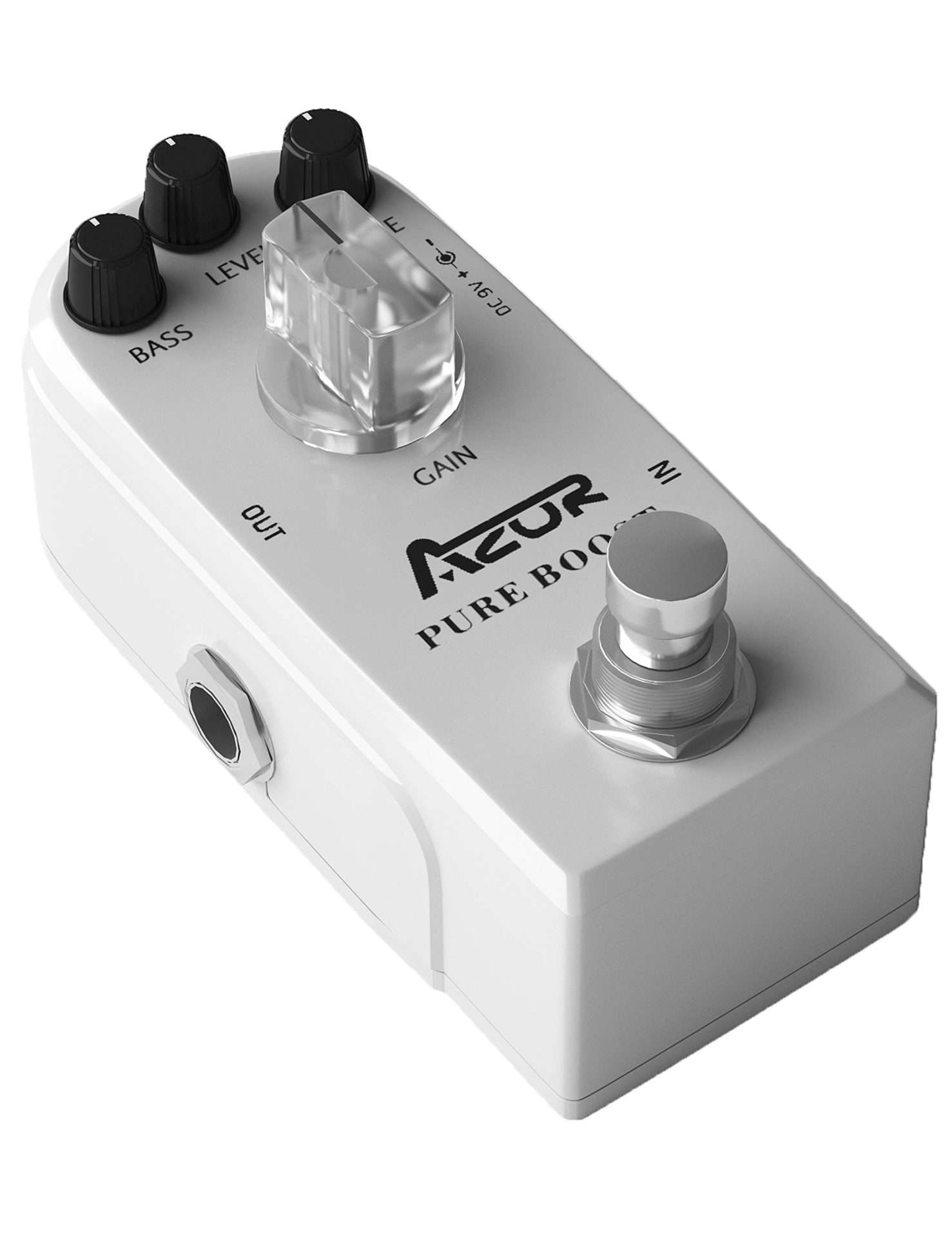
We find the AZOR Pure Boost Pedal delivers a significant enhancement, making your guitar sound richer and fuller without breaking the bank.
Pros
- Infuses life into your sound with a clean 20db+ boost and a 2 band EQ
- The compact design fits easily on any pedalboard and is simple to transport
- Impressive build quality for its price point, providing durability and reliability
Cons
- Some may prefer more than the provided ±15db EQ range for tone shaping
- With high gain settings, it introduces feedback, which is common but may require management
- Might not suit those looking for a boost pedal with additional features or effects
When we plugged in the AZOR Pure Boost Pedal, our guitar tone instantly transformed. The added depth and clarity it offers are sure to satisfy guitarists looking to make their sound stand out in the mix. This pedal feels intuitive, with three knobs for bass, tone, and volume, allowing for swift on-the-fly adjustments during live performances or recording sessions.
Its miniature size was a pleasant surprise. We could easily find a space for it on our crowded pedalboard. Despite its small stature, it packs a punch, serving up that extra ‘oomph’ without altering the original tone—exactly what we’re looking for in a clean boost pedal.
The AZOR Pure Boost is a no-frills, sturdy little piece of kit that should last a long time, even with regular use. It’s a workhorse that gives our guitar sound a nice kick without introducing noise. However, when we cranked it up, there was a bit of feedback, reminiscent of other pedals at similar gain settings. It’s nothing a seasoned guitarist can’t handle, but it’s something to keep in mind.
Summing up, we find the AZOR Pure Boost a solid choice if you’re after a straightforward, effective boost. Whether it’s for solos that need to cut through the mix or just elevating your overall sound, this little white pedal is both a subtle enhancer and a robust sonic ally.
Kmise Roll Boost Pedal
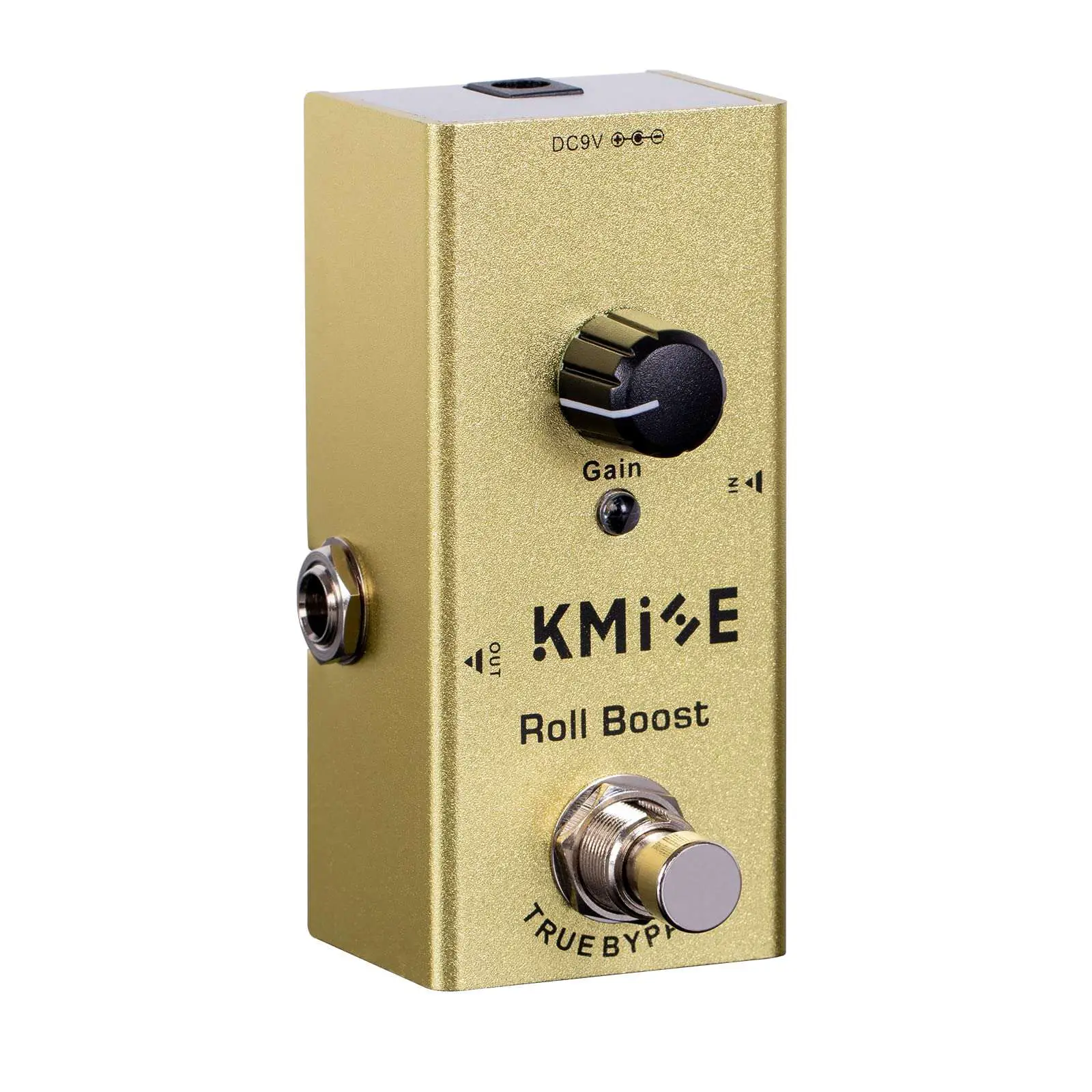
We think that the Kmise Roll Boost Pedal is a solid choice for guitarists who need a reliable boost without breaking the bank.
Pros
- Offers a noticeable noise reduction for cleaner sound
- Maintains signal integrity with true bypass
- Robust aluminum construction, perfect for gigging
Cons
- Lacks a power adapter, requiring an additional purchase
- Might introduce some noise at higher settings
- Limited tonal shaping compared to more complex pedals
The Kmise Roll Boost Pedal recently made its way onto our pedalboard, and we’ve been genuinely impressed with its performance. The true bypass design ensures that our guitar’s signal stays pristine when the pedal isn’t engaged. The noise reduction feature has been a godsend, keeping unwanted hiss at bay, which is particularly noticeable when we chain it with other effects.
On stage, the little unit feels like it can take a beating, thanks to its stout aluminum alloy body. Its small footprint makes it a breeze to find space for, even on the most cramped pedalboards. Toning things down with its single knob control, we find ourselves able to achieve just the right amount of boost without spending precious minutes dialing it in.
In our experience, this pedal shines in its simplicity. That said, we do find ourselves wishing for a bit more versatility at times. When pushed hard, there’s a bit of noise, but it’s a trade-off we’re willing to make for how it preserves tone. Remember, you’ll need a 9V adapter since it isn’t included, but that’s hardly a dealbreaker given its affordable price tag.
Buying Guide
Key Features to Consider
When selecting a boost pedal, we examine the following key features:
- Gain Range: A broader gain range offers more versatility for either a slight volume bump or a significant boost.
- True Bypass: This ensures that the pedal doesn’t affect the signal when disengaged.
- Size and Build: Compact and sturdy construction is crucial for pedalboards with limited space and frequent use.
- Power Requirements: We look for compatibility with standard pedalboard power supplies.
Sound Quality
Assessing sound quality involves listening for:
- Transparency: The pedal should maintain the guitar’s original tone.
- Noise Level: Lower noise levels are preferable for a cleaner signal.
Usability Features
For ease of use, consider:
- Ease of Access: Knobs and switches that are easily adjustable during live performance.
- Versatility: The ability to use the pedal in various settings and with other pedals.
Price
Price-performance ratio is vital:
- Value for Money: We ensure that the pedal offers the desired features without overpaying.
By keeping these aspects in check, we can help in making a well-informed decision.
